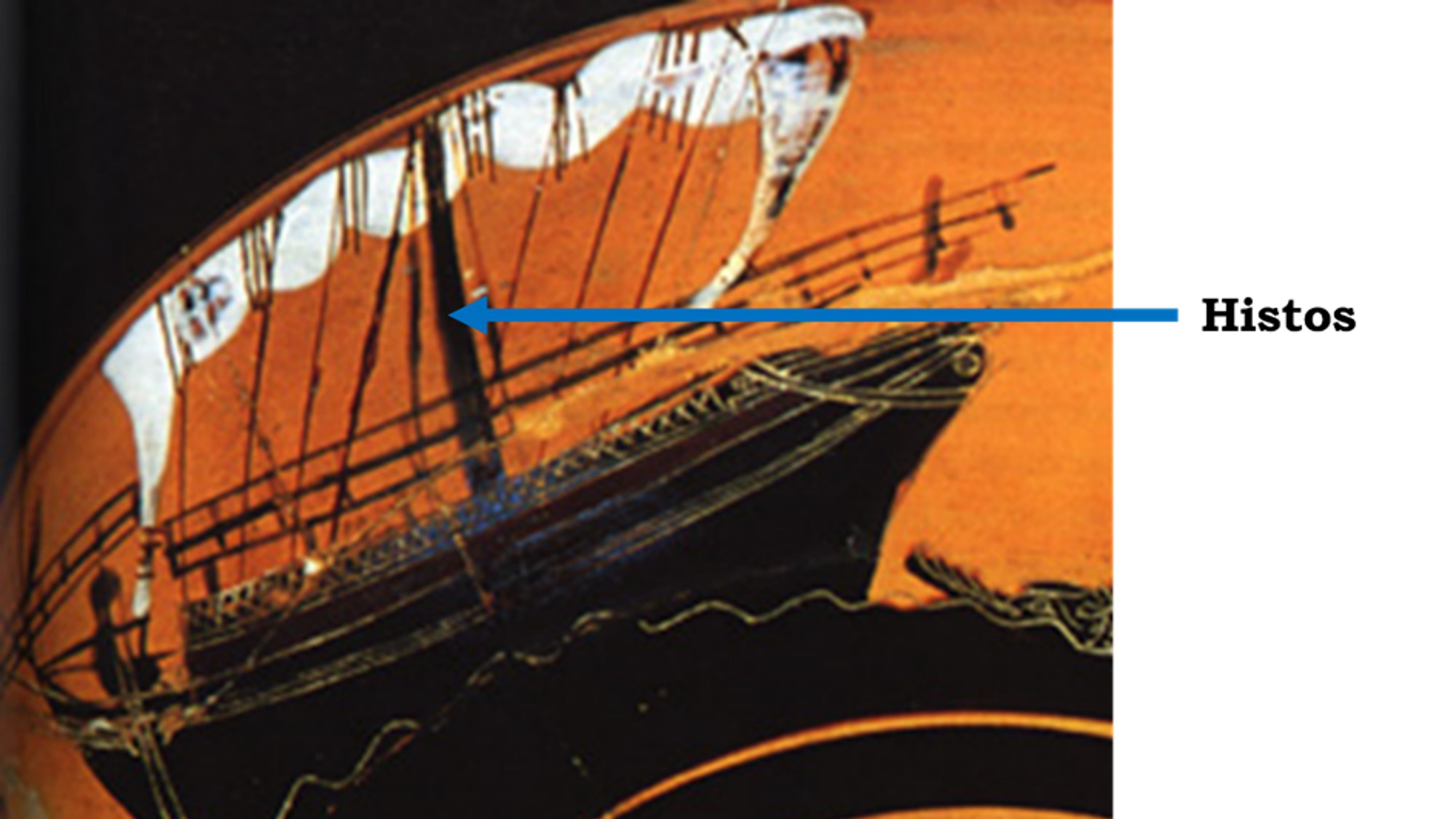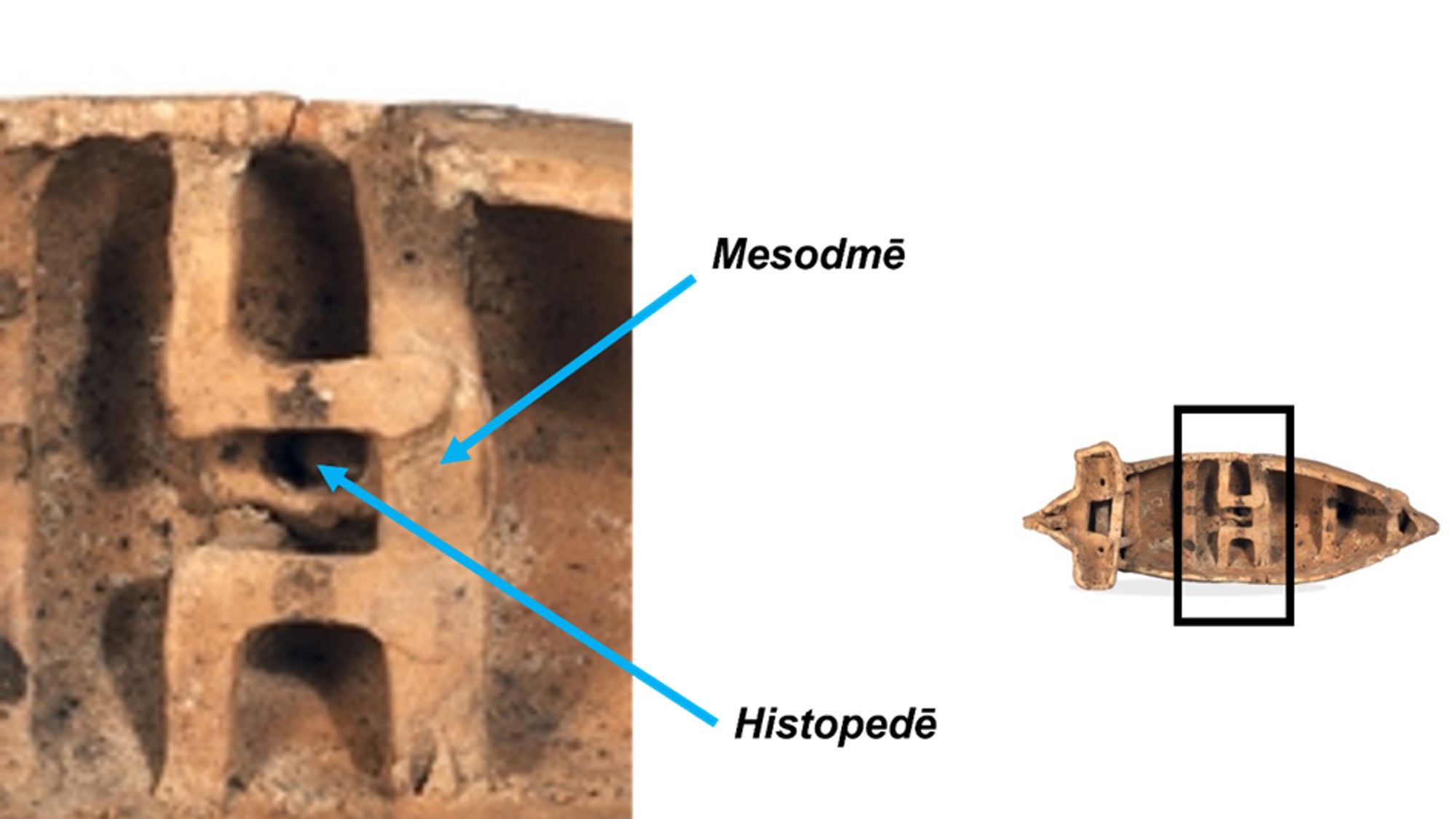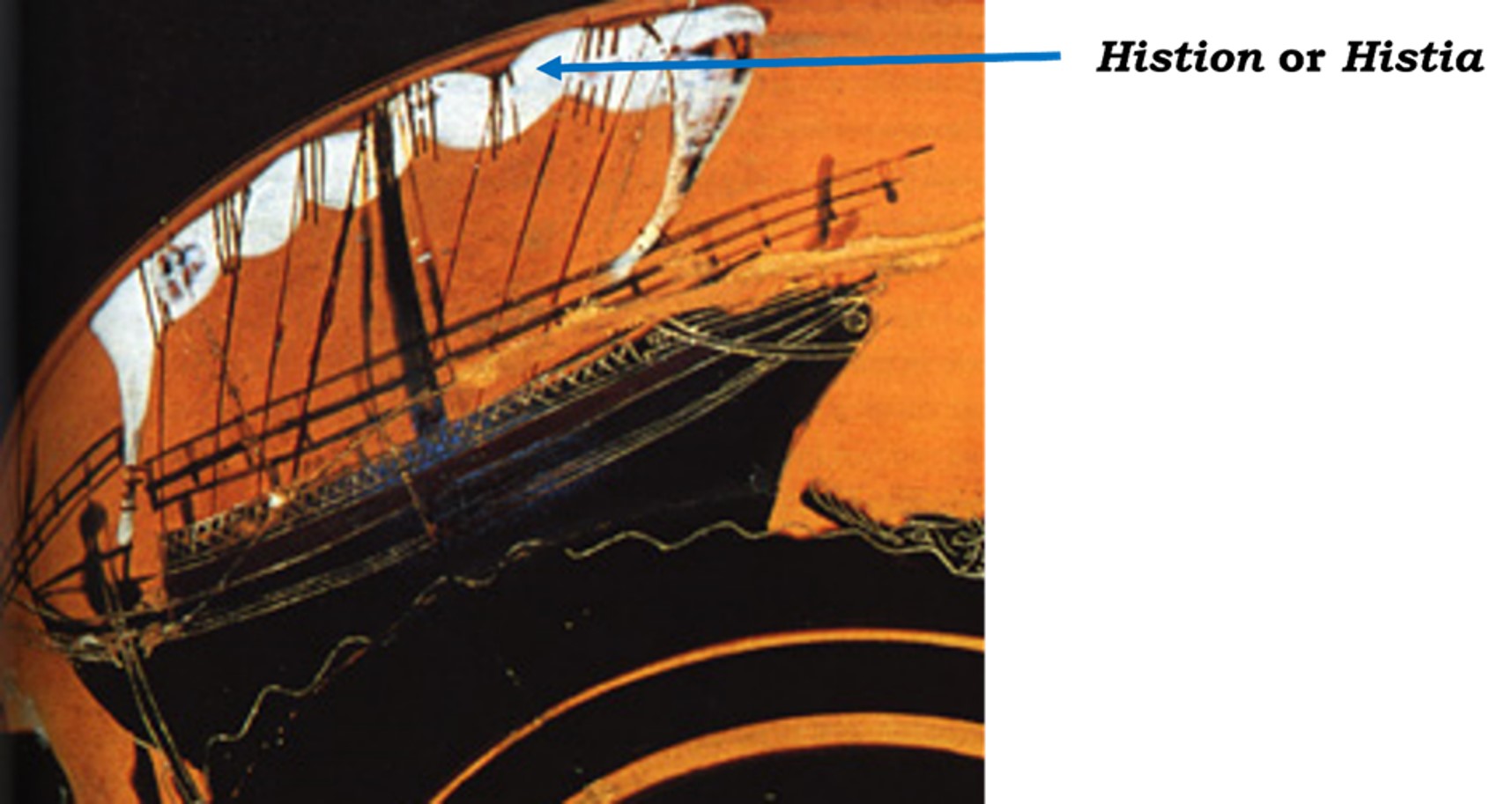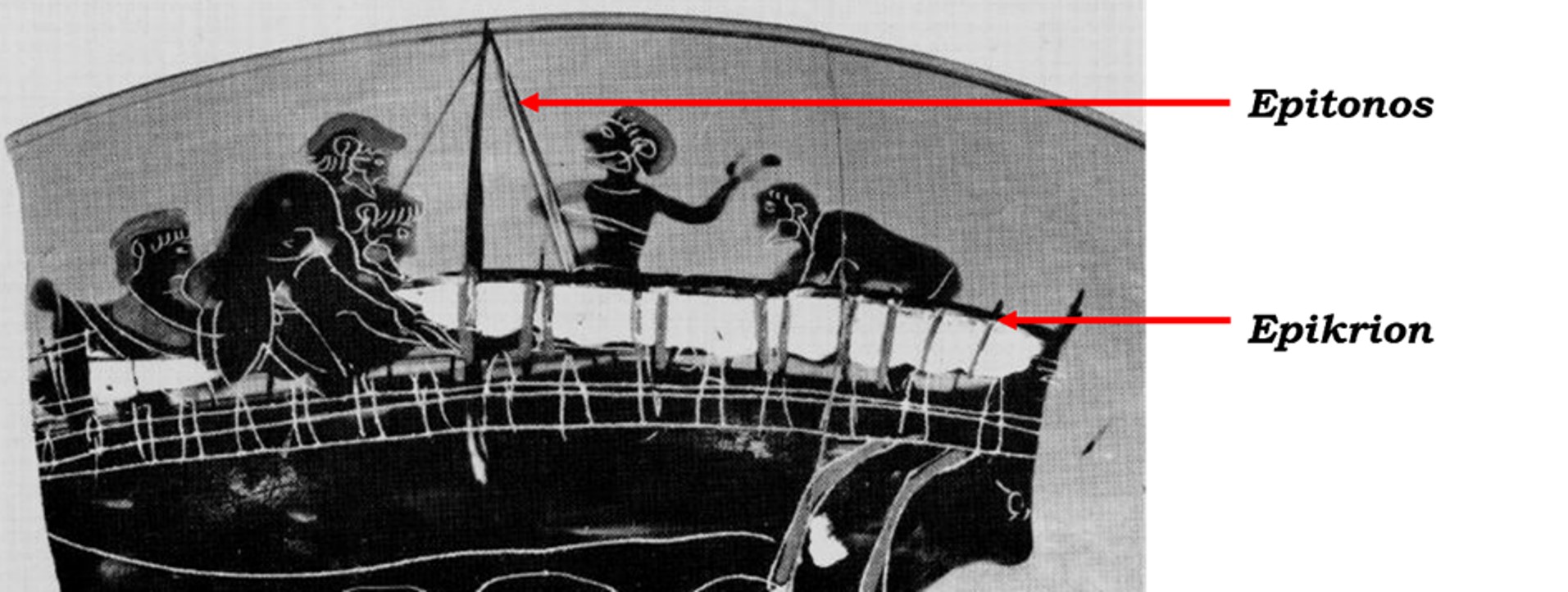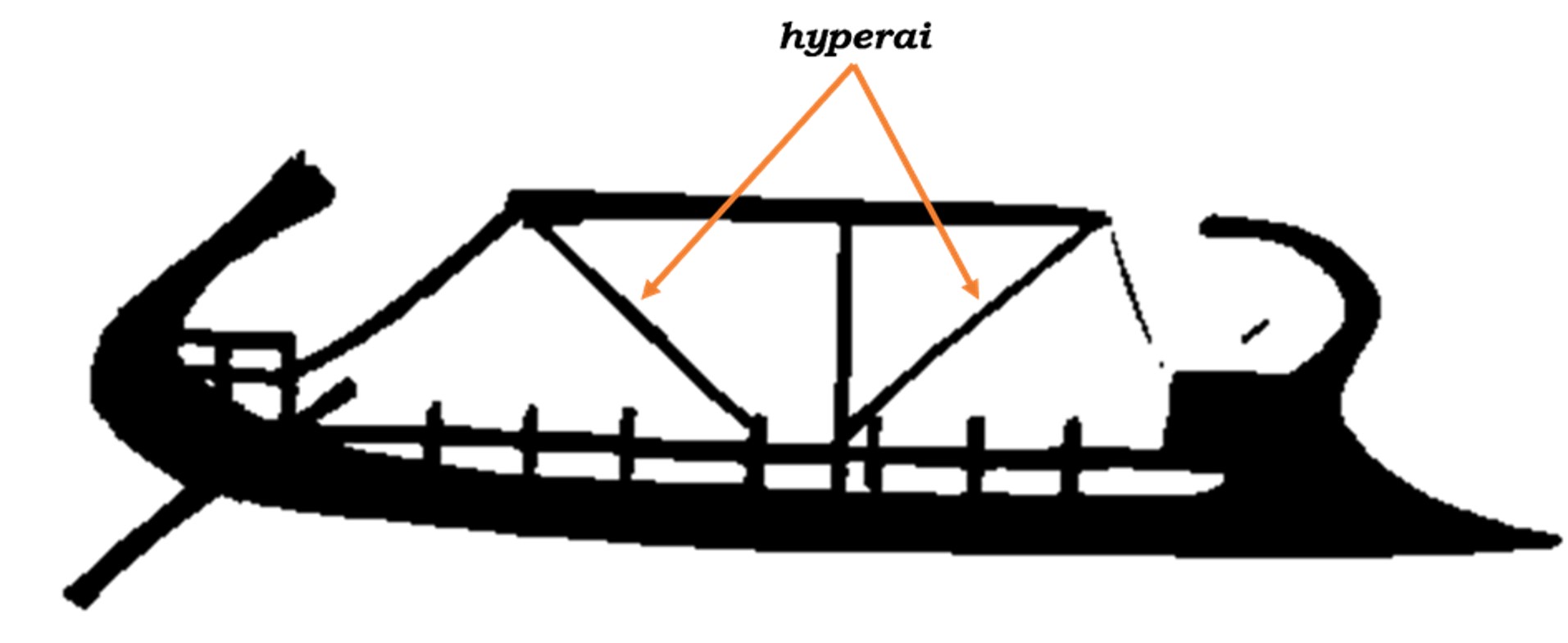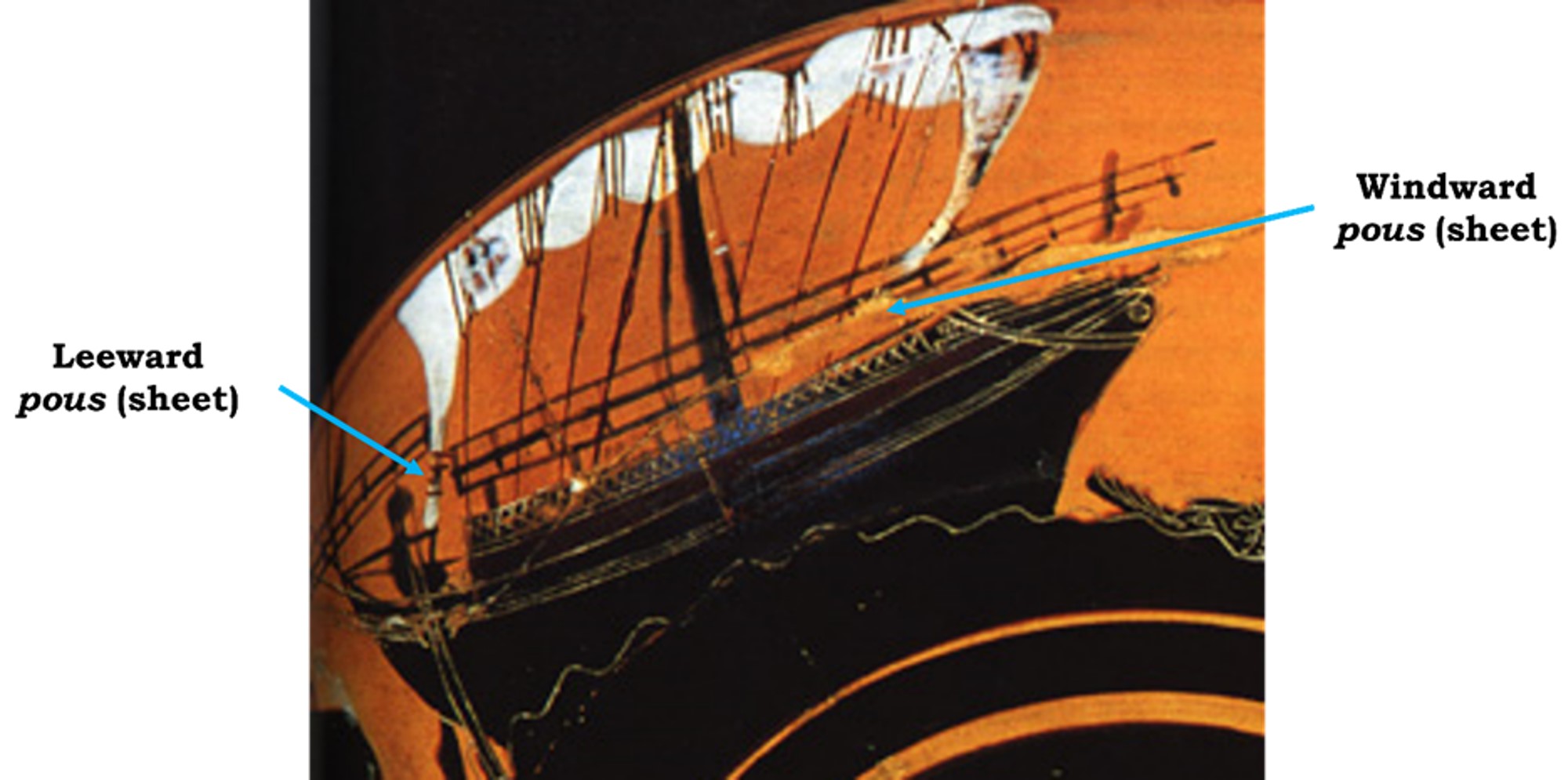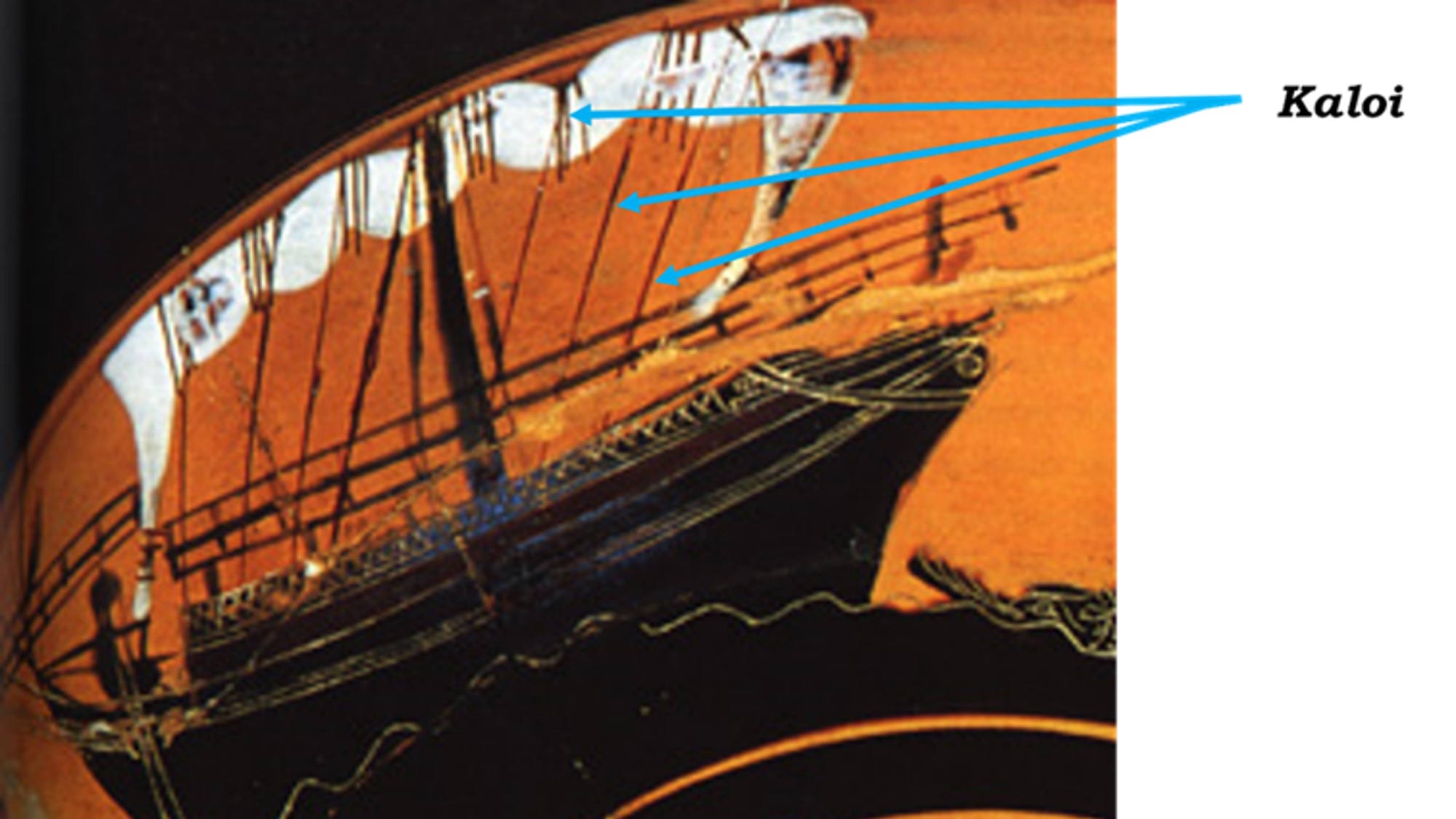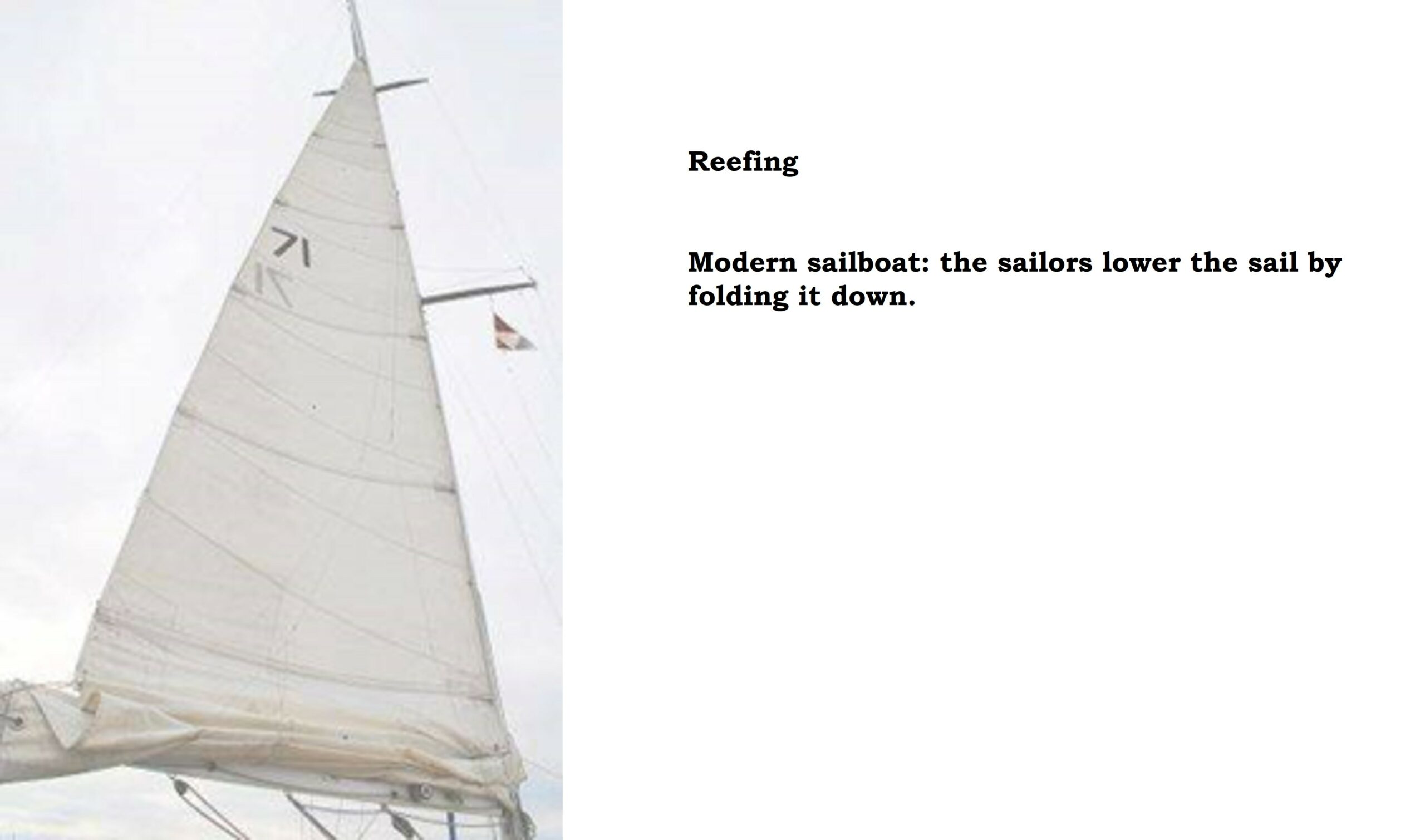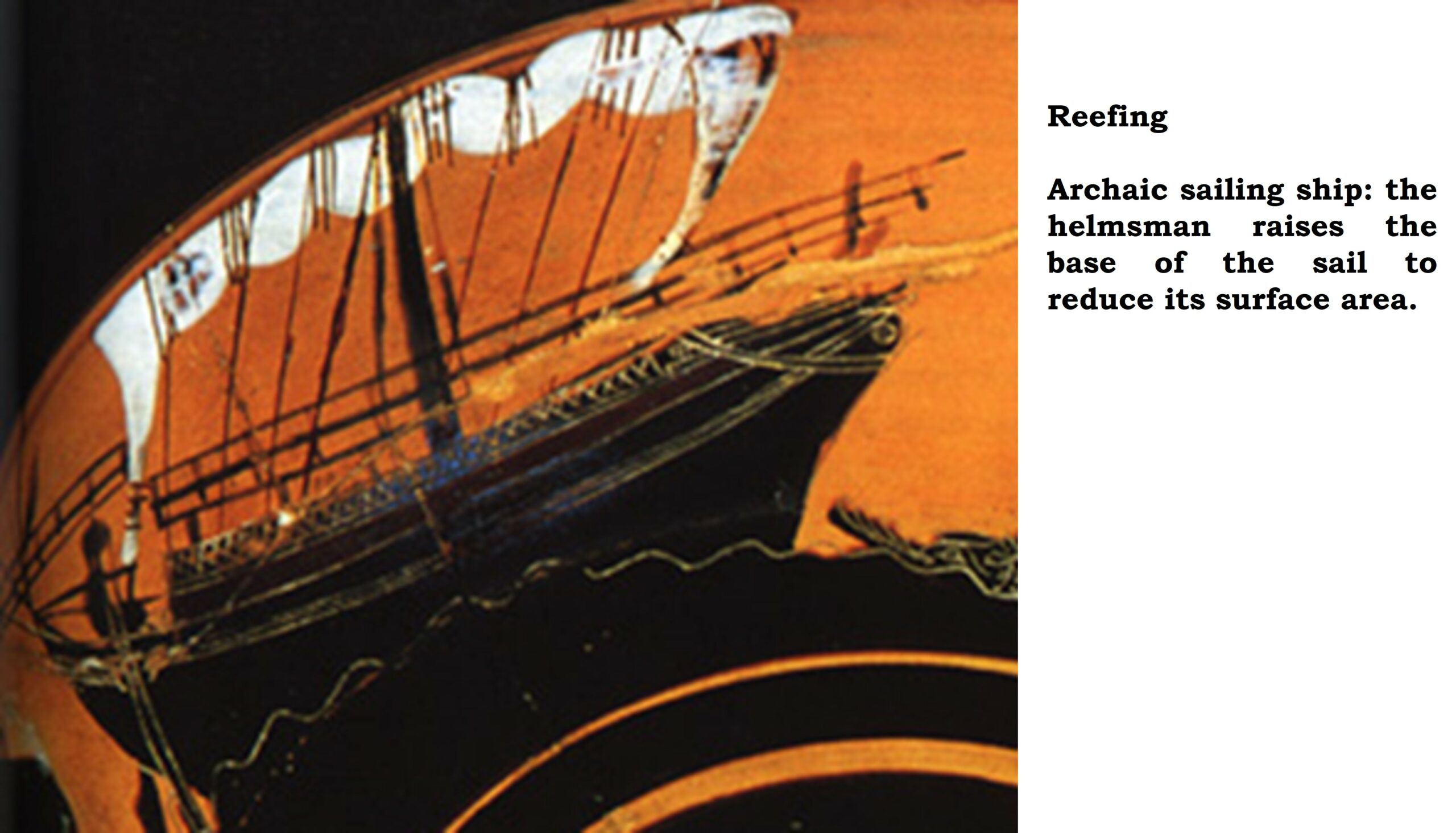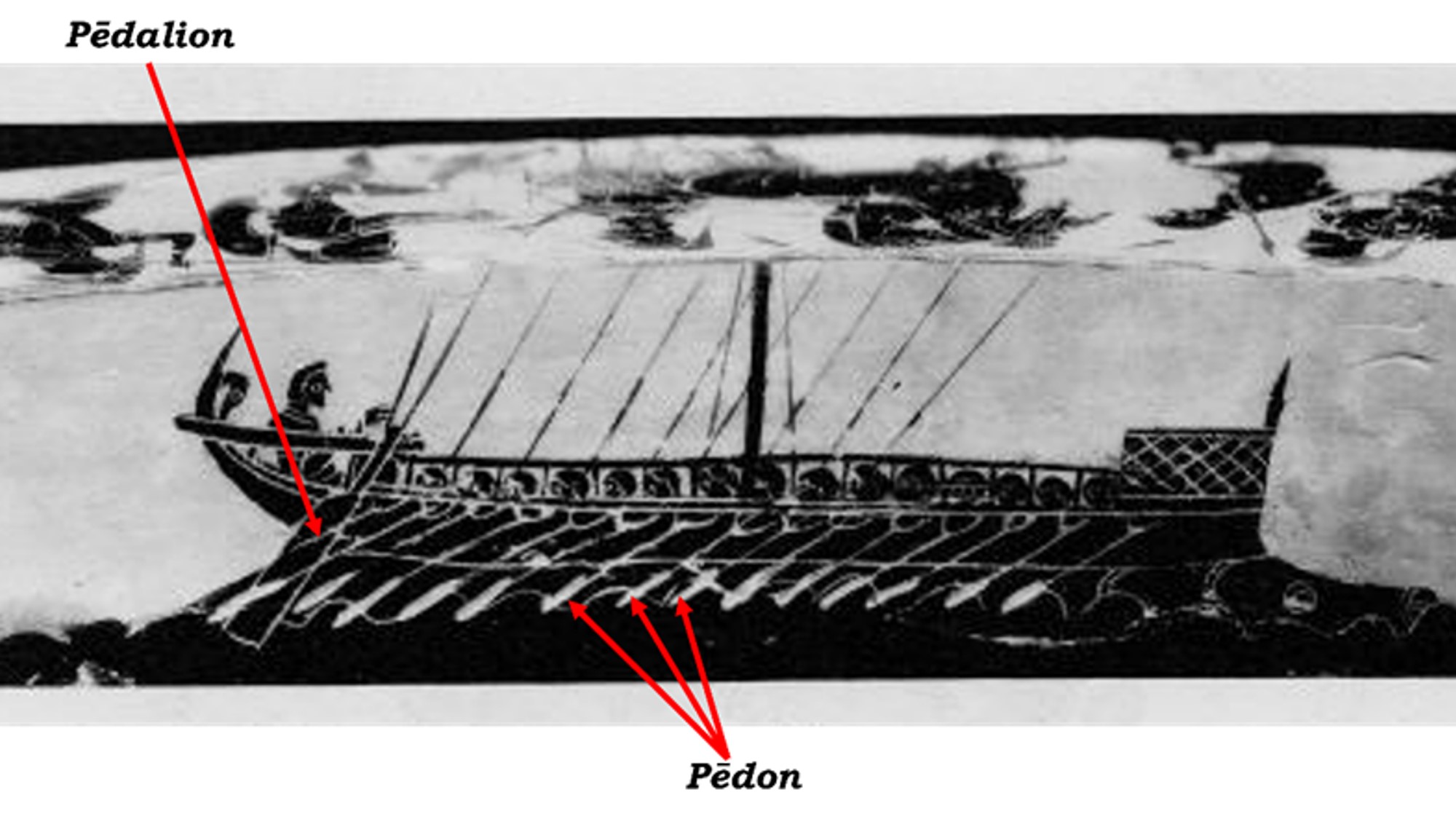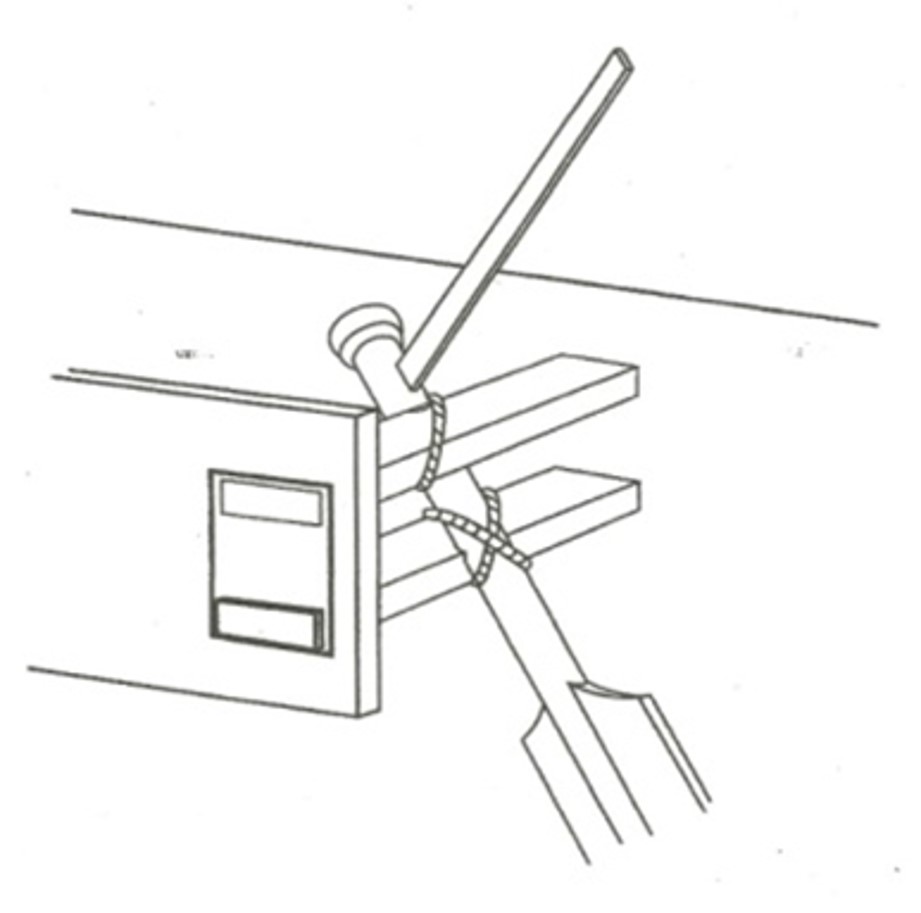Antypas, Constantine. 2023. “Navigating an Archaic Era Sailing Ship: Basic Guidelines for a Helmsman.” In “Γέρα: Studies in honor of Professor Menelaos Christopoulos,” ed. Athina Papachrysostomou, Andreas P. Antonopoulos, Alexandros-Fotios Mitsis, Fay Papadimitriou, and Panagiota Taktikou, special issue, Classics@ 25. https://nrs.harvard.edu/URN-3:HLNC.ESSAY:103900174.
Sitting among the leaders of the Phaeacians, Odysseus recounts what he saw and what he suffered during his ten-year wandering in a strange world of monsters, witches, and miracles. At the most fascinating moment of the Nekyia, the hero cuts his narration short, saying that the time has passed. The Phaeacians, enchanted by his story, ask him to continue; κηληθμός is the word Homer uses to describe the feeling and the mood of Odysseus’ audience. [1]
The κηληθμός, the enchantment, was the aim of a professional rhapsode, and the poet of the Odyssey seeks to provoke the audience’s enchantment through a realistic representation of daily life, descriptive realism, and vividness. [2] According to Auerbach, in Homer there are no secrets; everything is externalized, offered to be understood down to the last detail. [3]
Homeric poems—at least, their oral version—probably took an almost final form on the east Aegean coast, in Ionia, sometime between the eighth and the sixth centuries BCE. [4]
The audience of the rhapsodes, in that era and that region, were seashore people, habitants of port towns, who were familiar with navigation and its language. If Homeric fiction aimed to legitimize its fables, it needed to respect the lived experience of its listeners; ships, distances, winds, sea currents, sailors’ behavior and technical data should construct a solid frame of realism supporting the fiction; if so, the Homeric information about seafaring reflects—more or less—the nautical experience and the actual conditions of navigation in the era of the epic’s final formation.
Mariners’ jargon does not have the luxury of abstract concepts and metaphorical function; nouns must define concrete and unique objects, adjectives must express visible or tangible qualities, verbs must denote definite actions and events. In sailing ships, where the coordination of the whole crew is required to execute a maneuver, the first piece of knowledge an apprentice must assimilate is the navigation idiom. Sometimes, the brevity of the command and its immediate understanding by the sailors, the accuracy and simplicity of this code are literally a matter of life and death.
Of course, there is a major problem: we do not know precisely whether the epics use naval terms of the period in which Iliad and Odyssey took their final written form or of another, earlier period. Scodel has argued that a relationship of sympathy connected the epic narrative to listeners. [5] It is self-evident that in the port cities of the Archaic Aegean, where the song of the rhapsodes was heard, a large part of the audience consisted of sailors; moreover, in such cities, so closely connected with the sea, the whole audience was familiar with nautical language. It would not be possible to create the necessary relationship of sympathy if the terms used for the sea, the voyage, and the ship were poetic neologisms or archaisms: the people of the sea would pay no attention to an artificial poetic vocabulary with a nautical connotation; sailors, everywhere and always, want to hear their own language in narratives about their own life.
Therefore, in our attempt to approach the maritime experience of an Archaic Era helmsman, we will use the Archaic epic vocabulary for ships and their voyages, assuming that, in general, it is the contemporary nautical vocabulary of the period between 800 and 500 BCE. Of course, archaisms in the form of formulae have survived within the epic verses, but this does not change the big picture.
The duties of a helmsman
The helmsman (κυβερνήτης or κυβερνητήρ [6] ) was the most important member of an ancient sailing ship’s crew; he alone was charged with setting the course of the ship, and he was the one whom the crew trusted with their lives.
An Archaic era ship, like any vessel sailing without the aid of modern nautical instruments and charts, was oriented either by visual contact with land or by observing the position of celestial bodies. When in visual contact with the land, the helmsman headed towards a specific landmark: a pointed rock, an oddly shaped mountain, a promontory, or a distinctive human structure. After the ship reached the landmark, the helmsman set a new target, adjusting the sail and the course; or, otherwise, he would moor, and wait for the dawn or a favorable wind. When sailing in the open sea, he would orient himself by the sun and the stars.
After the choice of the optimal route, the duties of a helmsman were two:
- to keep the sail always trimmed, and
- to correct the course when the ship sheered.
For the first task, he would use the rigging of the ship; for the second one, the quarter rudder or rudders.
Sailing with the wind
The components of the sailing apparatus were a mast, a yard, a rectangular sail, and several ropes.
The single mast of Archaic ships is called ἱστός, [7] a word cognate with the verb ἵστημι. [8] Its original meaning was “that which stands and remains standing.” In this sense, ἱστός was used to designate two upright mechanisms: the ancient upright loom [9] and the mast of a ship.
The mast was made out of a fir trunk. [10] According to literary and iconographic information, its height equaled a little less than the half of the overall length of the ship. For example, if an Archaic era merchantman was about 20 meters long, then its mast, from the mast step to the top, was at most 10 meters high. However, it is very likely that there was a different ratio of mast height to ship length in different types of vessels, as is the case with modern-day sailing ships.
The lower side of the mast—as in all sailing ships of any period—was attached to a mast step. The stresses exerted on the mast during the voyage are great, therefore it is not enough to place the base of the mast into a simple hole on the bottom of the boat. A sophisticated mechanism was needed to ensure that the mast would not shatter during the voyage and ensure an easy disassembly of the mast when the ship was moored. This mechanism consisted of two parts: the ἱστοπέδη [11] and the μεσόδμη. [12]
We can understand the term ἱστοπέδη as “the device where the mast is secured.” A merchantman clay model from Cyprus perhaps offers an image of this device. At the bottom of the hull we can see amidships a strong wooden box with a hole where the mast was stepped; this mast step is probably an ἱστοπέδη.
If that is true, then we assume that the mast is placed inside the hole of the ἱστοπέδη, first passing through a special slot in the μεσόδμη. Thus, the mast has not one, but two points of support, which is necessary for the stability of a structure that must withstand strong wind pressures. Also, the mast can be easily removed and lowered towards the stern, to be placed in the ἱστοδόκη. [13] Whether this ἱστοδόκη (that is, the mechanism which receives the mast when it is removed and stored in a horizontal position) is a forked timber or some other device, is of little consequence to the ship’s operation.
Note that there were probably many ways of placing and supporting the mast: different types of ships need masts of different heights, and therefore different systems of securing the mast.
The one and only sail of a merchantman is called ἱστίον or ἱστία. [14] The plural ἱστία is related to the way the sail was fabricated: many rectangular pieces of cloth (φάρεα) [15] were sewn together to make a sail. As the fabrics were only produced using the ancient standing loom, the need to sew together many pieces of cloth was dictated by the limited dimensions of this device.
The mast’s yard is called ἐπίκριον. [16] The yard could be placed higher or lower on the mast by a special rope, the ἐπίτονος, [17] and moved to the right or left by two ropes (ὑπέραι) [18] tied to its two ends. The question is why the yard is called ἐπίκριον. Perhaps, the only logical answer is the interpretation of Eustathius, that, in the past, ἰκρίον had also the meaning of “mast,” so ἐπίκριον is a device on the mast. [19]
In navigation, the word ὅπλον [20] was a general term for all ship’s ropes. The ὅπλα used for sailing were called ἐπίτονος, ὑπέραι, πόδες and κάλοι.
The ἐπίτονος was a rope made of oxhide [21] and was mainly used to raise or lower the yard. Of all the ship’s ropes, only the ἐπίτονος is explicitly mentioned as being made of leather. The hoisting of the ἐπίκριον was done from the stern’s deck. The sailors hoisted the leather ἐπίτονος that passed through a kind of ring or a hole at the top of the mast and was tied exactly at the center of the yard. The combined weight of the yard and the sail was considerable; a leather rope has less friction at the point of contact than a vegetable rope, so hoisting was somewhat easier.
The ἐπίτονος was not only used to handle the yard, but it also served to reinforce the overall support mechanism of the mast during the voyage.
Wind stresses required the ἐπίτονος to not only be strong, but also elastic, as gusts and sudden changes in wind direction create situations of great tensions on the rope; a vegetable rope without sufficient elasticity is much more likely to break compared to a leather ἐπίτονος.
The ὑπέραι were the two ropes that were tied to the ends of the yard and directed it to the appropriate position in relation to the wind. The word ὑπέραι derives from the preposition ὑπέρ (above) and is consequently opposed to πόδες [22] (feet), the ropes that were tied to the lower corners of the sail. Therefore, the two “upper” ropes (ὑπέραι) adjusted the sail in relation to the direction of the wind and the two “lower” ropes (πόδες) regulated it in relation to the intensity of the wind, so that it was always trimmed. In general, the ὑπέραι correspond to the halyards of modern sailing ships and πόδες to the sheets.
The operator of all four ropes was the helmsman, because the navigation of a sailboat requires rudder and sail coordination to keep the sails always full and the course smooth. If we judge from the Odyssey’s account of the journey from the island of Aeolus to Ithaca, the helmsman handles only the leeward πούς (sheet), while the other three ropes are firmly attached to a fixed point on the stern. [23] Of course, at every change of wind, either in direction or intensity, the helmsman would readjust the sail by adjusting the four ropes.
When Odysseus finished building his raft, he placed ὑπέραι, κάλοι, and πόδες [24] as a final addition. If we accept this order, the κάλοι are the ropes adjusting the surface of the sail. Herodotus sheds some light on the use of these ropes, mentioning that the hulls of most Mediterranean ships were tied to the outer side of the sail. [25]
Putting together the available information, we assume that κάλοι are not generally the ship’s ropes, as Lorentzatos maintains, [26] nor the rope for hoisting the ἐπίκριον, as mentioned in Cunliffe’s Homeric Dictionary, [27] but the reefing rope, a rope used in order to reduce the sail surface. We must note that Archaic sailors reefed the sail in a very different way compared to modern sailors. Literary descriptions and pictorial evidence indicate that the κάλοι were passed through loops sewn into the base of the sail. The κάλοι ran the sail from the base to the yard and from there extended to the stern, towards the helmsman. The latter could reduce or increase the surface of the sail, depending on the intensity and direction of the wind, by wiring or furling the sails and tying them to a fixed point on the stern. [28]
Archaic ships reduced the surface of the sail by pulling its lower edge towards the ἐπίκριον. Therefore, the way in which an ancient ship reduced its sail area is the opposite of that of a modern sailboat: the ancient ship’s sailor raised the low edge of the sail to reduce its surface area, while the modern sailor lowers the sail by folding it down.
The invention of κάλοι, combined with the free lower edge of the sail, increased the sailing capabilities of Mediterranean ships: compared to ships that used booms (such as the Egyptian or Creto-Cycladic ones of the Bronze Age), the vessels with a free lower edge of the sail could navigate in stronger winds, since they were able to effectively reduce their sail area; also, the ability to shape the sail from trapezoidal to triangular allowed the boat to get a bit more upwind; [29] finally, these sail capabilities allowed the helmsman to react faster in sudden wind changes. The literary sources, as well as common sense, lead us to assume that the ἐπίκριον of the Archaic merchantmen would be placed lower on the mast, as the wind got stronger.
A sixth century BCE kylix depicts sailing with a strong wind, as demonstrated by the height of the waves. From the setting of the sail, clearly pointed to the port side of the vessel, we understand that starboard is the windward side. The helmsman has tied the starboard sheet and handles the port side sheet. The sail area has been reduced by using six κάλοι, so that the intensity of the wind does not endanger the ship (Figures 7 and 8).
Steering an Archaic age sailing ship
Πηδάλιον was the word for the rudder of a ship. [30] The noun πηδάλιον derives from πηδόν, the broad part of the oar.
The rudder was not just a large oar; it was a mechanism that required skill and expertise.
Ancient seafaring vessels had only quarter rudders. The reason for the use of such rudders was the simplicity of their construction and their effectiveness. Of course, the simplicity of their construction does not mean that the quarter rudders were a simplistic mechanism: as early as in the middle of the third millennium BCE, quarter rudders were already a sophisticated steering system, constantly adapting to the needs of each era. [31]
No ancient writer has bothered to describe precisely how the quarter rudders worked. After all, who among their readers needed such a description? Thus, we find several references to the movement of the quarter rudder, but without explanatory information to clearly understand its function.
In Plato’s Alcibiades I, Socrates asked his young disciple: Should we move the rudder outwards or inwards? [32] The phrase has no clear meaning to us: was the movement of the rudder effected by pushing its οἴαξ, the handle, to the outside of the ship and, correspondingly, by pulling it inward, as Morrison supposed, [33] or do we have a rotation of the handle about its axis, to the right and to the left, as argued by Casson? [34] Experimental archaeology provided the answers: after the tests of two ancient ship replicas, Kyrenia II and Olympias, it is now clear that the helmsman used the quarter rudder by turning it about its axis. [35]
Ships did not sail with both rudders submerged, but usually only the leeward rudder was in the sea, while the windward rudder was in the air. The tests of Kerynia II and Olympias showed that if the ship sailed with both rudders immersed in the water, the increased drag force would significantly reduce the speed and the rudder blades would wear out faster; these findings confirm some Hellenistic pictorial evidence about the use of a single rudder while sailing. [36]
In specific cases, the use of both rudders was necessary: for maneuvering within a limited space, such as in harbors or straits, as well as for evading a dangerous situation or sailing in broad reach.
Bibliography
Antypas, K. 2019. Υγρά κέλευθα . Πλοία και ρότες στην Ομηρική εποχή (1000 – 500 π.Χ.). Athens.
Auerbach, E. 2015. Mimesis: Dargestellte Wirklichkeit in der abendländischen Literatur. Tübingen. Orig. pub. 1946.
Beekes, R. 2010. Etymological Dictionary of Greek. Leiden.
De Jong, I. J. F. 2005. “Convention versus realism in the Homeric epics.” Mnemosyne 58:1–22.
Casson, L. 1995. Ships and Seamanship in the Ancient World. Rev. ed. London.
Cunliffe, R. G. 2012. A Lexicon of the Homeric Dialect. Expanded Ed. Norman, OK. Digital ed. in Thesaurus Linguae Grecae. http://www.tlg.uci.edu/cunliffe.
Lassere, F. and Ν. Livadaras. 1976–1992. Etymologicum magnum genuinum. Symeonis etymologicum una cum magna grammatica. Etymologicum magnum auctum. Athens.
Stallbaum, J. G. 2010. Eustathii Commentarii ad Homeri Iliadem. Leipzig. Orig. pub. 1827.
Lorentzatos, P. 1925. Ομηρικόν Λεξικόν μετά Εικόνων. Thessaloniki.
Morrison, S. J., and R. T. Williams. 1968. Greek Oared Ships: 900–322 B.C. Cambridge.
Mott, L. 1997. The Development of the Rudder: A Technological Tale. London.
Nagy, G. 1980. “An Evolutionary Model for the Text Fixation of Homeric Epos.” In Oral Traditional Literature: A Fetschrift for Albert Bates Lord, ed. J. M. Foley, 390–393. Columbus.
———. 1990. Pindar’s Homer. Baltimore.
———. 1999. The Best of Achaeans. Concepts of Hero in the Ancient Greek Poetry. 2nd rev. ed. Orig. pub. 1979. Baltimore.
Powell, B. 1991. Homer and the Origin of the Greek Alphabet. Cambridge.
Scodel, R. 2002. Listening to Homer: Tradition, Narrative, and Audience. Ann Arbor.
Seymour, T. 1914. Life in the Homeric Age. New York.
Τζαχίλη, Ι. 1997. Υφαντική και Υφάντρες στο Προϊστορικό Αιγαίο 2000–1000 π.Χ. Herakleion.
Footnotes
[ back ] 1. Odyssey 11.334.
[ back ] 2. De Jong 2005:6.
[ back ] 3. Auerbach 1946:6–27.
[ back ] 4. Nagy 1980:391; Nagy 1990:53; Powell 1991:231–237; Nagy 1999:Introduction.
[ back ] 5. Scodel 2002:173–212.
[ back ] 6. Κυβερνήτης: Iliad 19.43; Odyssey 9.78; Aeschylus Supplices 770; Herodotus 2.164. Κυβερνητήρ: Odyssey 8.557.
[ back ] 7. Iliad 23.852; Odyssey 15.289; Xenophon Hellenica 6.2.29.
[ back ] 8. Beekes 2010:602.
[ back ] 9. Τζαχίλη 1997:157 et passim.
[ back ] 10. Odyssey 2.424.
[ back ] 11. Odyssey 12.51; Alcaeus 18.6.
[ back ] 12. Odyssey 2.424.
[ back ] 13. Iliad 1.434; Etymologicum Magnum 478.30.
[ back ] 14. Odyssey 2.426; Herodotus 4.110; Aristophanes Ranae 999.
[ back ] 15. Odyssey 2.258.
[ back ] 16. Odyssey 5.254; Apollonius Rhodius Argonautica 2.1262.
[ back ] 17. Odyssey 12.423.
[ back ] 18. Odyssey 5.260; Lucianus Dialogi Mortuorum 4.1.
[ back ] 19. Eustathius Commentarii 1533.31.
[ back ] 20. Odyssey 2.390; Hesiodus Opera 626.
[ back ] 21. Seymour 1914:333n.1.
[ back ] 22. Odyssey 5.260; Euripides Orestes 707; Aristophanes Equites 436.
[ back ] 23. Odyssey 10.32: ἀεὶ γὰρ πόδα νηὸς ἐνώμων.
[ back ] 24. Odyssey 5.260.
[ back ] 25. Herodotus 2.36.4.
[ back ] 26. Lorentzatos 1925, s.v. κάλος 201.
[ back ] 27. Cunliffe 2012, s.v. κάλος.
[ back ] 28. Morrison and Williams 1968:56.
[ back ] 29. Pseudo-Aristoteles Mechanica 851b; Achilles Tatius 3.1.1–2.
[ back ] 30. Odyssey 3.281; Herodotus 2.96; Aristophanes Equites 542.
[ back ] 31. Antypas 2019:253.
[ back ] 32. Plato Alcibiades I 117d.
[ back ] 33. Morrison and Williams 1968:291–292.
[ back ] 34. Casson 1995:225n.5.
[ back ] 35. Mott 1997:21.
[ back ] 36. Mott 1997:48, 50–52.

